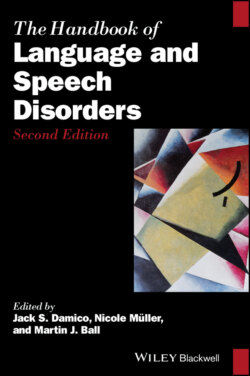Читать книгу The Handbook of Language and Speech Disorders - Группа авторов - Страница 35
2.6 Relevant Applications
ОглавлениеApplications of diversity content in clinical service provision present both challenges and opportunities. The challenges are mostly the result of the diversified nature of the goals that need to be set to respond practically to the multifaceted demands of multicultural and multilingual diversity itself. Primary applications include client‐apposite service delivery in terms of assessment, intervention, and referral. This is challenging for a number of reasons.
First, without diversity awareness at the primary level, client profiles tend to be less meticulous, less systematic, less methodical, and focusing mostly on diagnostics without adequate consideration of the combined cultural and linguistic factors present, thus contributing to impressionistic (fuzzy) rather than realistic (detailed) portraits. Insufficient background information of this kind, combined with inadequate knowledge of diversity issues, in terms of how, for example, diglossia, bilectalism, bilingualism, and cultural tendencies affect behavior and linguistic output, leads to de facto or narrow assumptions of who the client is (identity/cultural being), which negatively affects the interpretation of evidence, and the resulting diagnostics. An example of that would be a child being treated for phonological protraction (delay) in Greek without the Greek SLP knowing that the child is being raised bilingually in Albanian and Greek—this is one of numerous actual cases. It is notable that minority stigma in majority communities has a negative effect on people’s identities, who tend to be politically correct, concealing, for instance, their cultural/linguistic history (and the need to honor that) as something to be ashamed of. The opposite may also hold; for instance, raising a child bilingually in an exogenous setting (i.e., exclusive foreign language input in the second language where the ambient community speaks the first language) meets with “reservations” from native speakers of both languages (Babatsouli, 2013). Cultural considerations in bilingual practices around the world ought to be a spotlighted arena when treating known, hidden, and even passive bilinguals with SLDs.
Second, it is widely acknowledged that there is a dearth of valid procedures and tools that are evidence‐based, culturally and linguistically appropriate, concerning the numerous blends of cultures/languages present in research and, by association, also in the clinic. In fact, every current study assessing any level of grammar in bilinguals has a paragraph stating that this is the case. Most recent work on such assessment and intervention procedures and tools include (but are not limited to): Arias and Lleó (2013), Armon‐Lotem et al. (2015), Babatsouli (2019b), Bernhardt and Stemberger (2017), Fabiano‐Smith (2019), Gildersleeve‐Neumann and Goldstein (2015), McLeod and Goldstein (2012), McLeod and Verdon (2017), McLeod and Crowe (2018), Stemberger and Bernhardt (2019), Williams, McLeod, and McCauley (2020), and so forth. The special issue by Verdon, Blake, et al. (2016) addresses issues in non‐mainstream language assessment. Also, Bernhardt et al. (2020) provide specific instructions for SLPs dealing with unfamiliar phonologies in bi‐/multilingual contexts. Associated obstacles also comprise the extent to which such tools are freely available for use and the degree to which they are adequately disseminated in a way that become known and relevant to service providers. Along with procedures and tools specifically designed to account for multilingual diversity, there are core procedures like those in contrastive analysis or evidence‐based analyses, and even theoretical frameworks like minimal core competency (e.g., Goldstein & Horton‐Ikard, 2010, and refs therein) that can play an alternate or ancillary role in unraveling diversity from impairment. Narrowing these gaps requires advances in research, boosting resources, information dissemination via further networking, and the development of partnerships at a local and international level, without undermining individual efforts.
Another challenge relates to whether clients and providers have access to external resources, like personnel (e.g., cultural/linguistic informants, interpreters, translators, bilingual service providers), products, and technology that facilitate effectual communication between them across settings. Such access is enabled by: first, knowing that one (client/SLP) is entitled to such support, and that such support is available; second, the availability of financial resources to permit the materialization of such support; third, the extent to which such support can operate on a volunteer basis across clinics, across states, across countries, as part of one’s current duties; and fourth, the establishment of a network that will run this. Caroline Bowen has been running a successful evidence‐based discussion group on therapy for SLDs since November 27 2001 (9,678 members; 26,654 posts to date) on a volunteer basis (E3BPforSSD: International Speech Sound Disorders Discussion for SLPs/SLTs, https://www.facebook.com/groups/795861360832928). The International Expert Panel on Multilingual Children’s Speech (www.csu.edu.au/research/multilingual‐speech/iepmcs) and the Crosslinguistic Phonology Project (http://phonodevelopment.sites.olt.ubc.ca/) are two more efforts that involve international collaborations, the first one bringing together SLPs, phoneticians, linguists, experts on SSDs and multilingualism in order to gather resources to support multilingual speech acquisition, and the second one bringing together linguists in order to advance research based on typical and protracted child phonological assessment using a consistent methodology across several languages.
In terms of opportunities, the presence of such consortia is an indication that international collaborative work that involves SLPs, linguists, sociolinguists, communication experts, speech, language and communication disorders experts, linguistic and cultural informants, and so forth, could be a first step toward addressing deficiencies in diversity expertise internationally. This type of networking could be part of the strategic plans and actions, and could even be run under the auspices of the established associations in this field: ASHA, WHO, and CPLOL (https://cplol.eu). An added intrinsic value is ongoing training, that is, the enhancement of cultural and linguistic competency and, most importantly, the confidence that emanates from knowing that one has a starting point when dealing with the stumbling blocks associated with cultural and linguistic diversity within one’s own clinic and as part of one’s standard clinical practicum.
